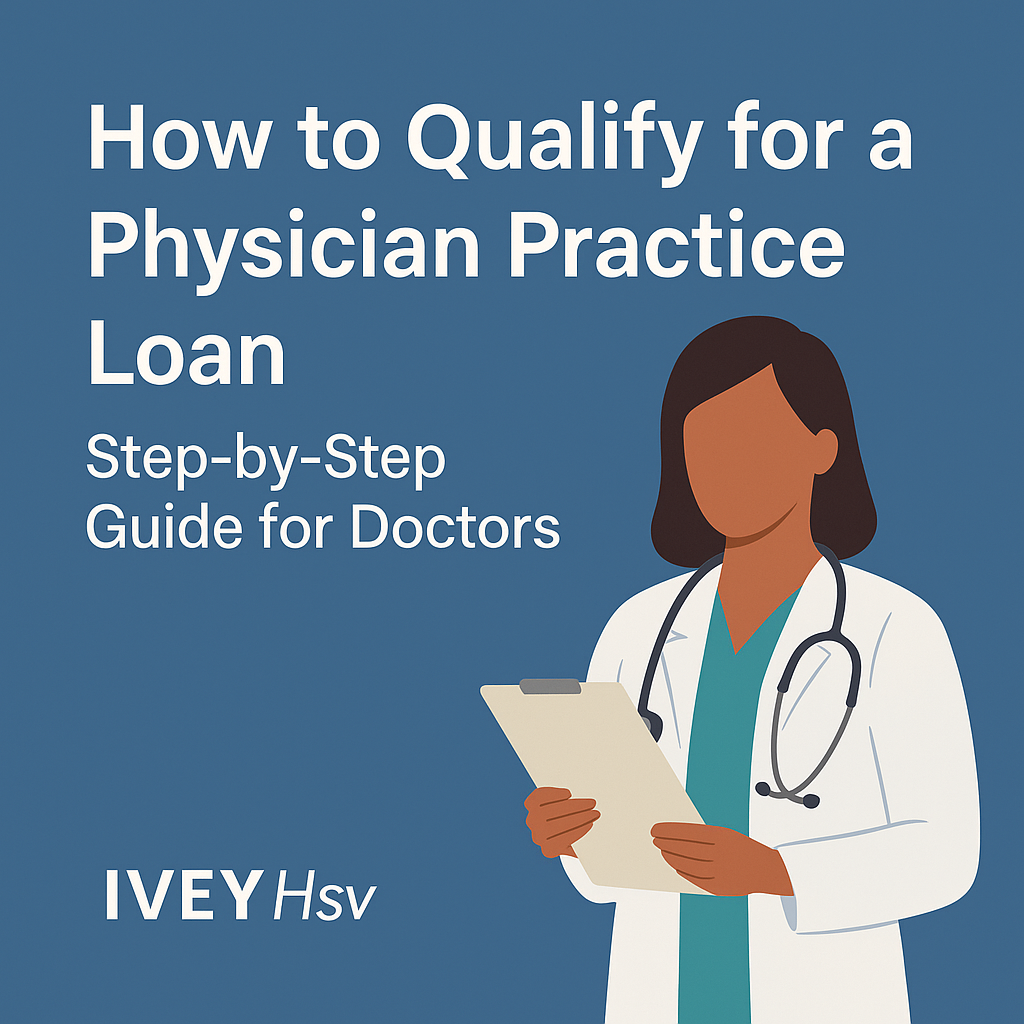SEO Meta Description: Learn how to qualify for a physician practice loan. Follow this step-by-step guide on requirements, documents, lender expectations, and approval tips for doctors buying into a medical practice.
How to Qualify for a Physician Practice Loan: Step-by-Step Guide
If you’re exploring ownership or buying into a group, a physician practice loan can bridge the gap between where you are and where you want to be. I’ve helped many doctors through this process in Huntsville, and my wife and I have been through similar financing steps ourselves—so this is a practical, real-world walkthrough, not theory. Below is a clear, step-by-step plan to qualify for a physician practice loan, improve your approval odds, and avoid the hidden pitfalls that slow doctors down.

Step 1: Get Clear on What a Physician Practice Loan Is (and Isn’t)
A physician practice loan is a specialized business loan designed for doctors buying into a partnership, acquiring shares, or purchasing an entire practice. Unlike generic small-business financing, a physician practice loan is underwritten with your future income, payer mix, and practice cash flow in mind. That’s why working with lenders who routinely fund medical transactions matters.
Typical uses include: buy-ins, buy-outs, partner succession, equipment, and limited working capital. If you’re relocating, pair the finance plan with our Physician Relocation FAQ and run scenarios in the Affordability Calculator to keep your personal budget aligned while you pursue the physician practice loan.
Step 2: Map Your Numbers Before You Talk to Lenders
Strong applications start with clean, believable numbers. Before requesting terms on a physician practice loan, pull these together:
- Personal financials: two years of tax returns, recent pay stubs or production reports, current CV, license/board certification.
- Debt snapshot: student loans (IBR/REPAYE details), credit cards, auto, mortgages—plus minimum payments.
- Practice package (if available): last 2–3 years of P&Ls, collections, payer mix, AR aging, and a draft buy-in agreement.
- Cash buffer: target 3–6 months of living + practice expenses post-close.
Pro tip: run a simple stress test. If collections dip 10–15% for a quarter, does the physician practice loan still pencil? Lenders appreciate seeing you’ve modeled the “what-ifs.”
Step 3: Strengthen the Pieces Lenders Care About
Small tweaks can move your physician practice loan from “maybe” to “approved.” Focus on:
- Credit score: 700+ helps; fix small delinquencies and lower utilization below 30%.
- Liquidity: demonstrate reserves; even $15–$30K in cash can comfort underwriters.
- Student loans: document IBR/REPAYE terms so the underwriter uses the correct payment in your DTI.
- Income stability: offer production trends or a signed contract to confirm post-close earning power.
Need introductions to local private banks that understand this? Email me to request the Preferred Lender List. The right relationship can make a physician practice loan simpler and faster.
Step 4: Choose the Right Lender (This Is Half the Battle)
Not all lenders underwrite the same way. Some national programs are fine, but many of the best physician practice loan terms I see are from smaller private banks that don’t advertise heavily. They look at your future as a five-star recruit—high potential, low default risk.
- Local/private banks: faster decisions, flexible structures, relationship-driven underwriting.
- National lenders: breadth of products, but sometimes less nimble for nuanced medical deals.
- SBA-backed options: useful in certain profiles, but more paperwork and longer timelines than a typical physician practice loan.
If you’re torn, reach out and I’ll help you compare real quotes side-by-side. Email me for a quick review and I’ll point you to the lenders that consistently close physician practice loan files for doctors here.
Step 5: Package a Clean, Lender-Ready Application
Your goal is to make underwriting easy. A crisp, complete package can shave weeks off your physician practice loan timeline:
- Deal summary: one-page overview—buy-in amount, structure, expected collections, transition plan, and why now.
- Practice story: payer mix, referral streams, growth projects (e.g., additional procedures or new satellite hours).
- Personal story: specialty track, board status, hospital affiliations, recruiting package if applicable.
- Documents index: label and date everything—tax returns, licenses, production, AR, P&Ls.
Think like an underwriter. If you answer obvious questions in the packet, your physician practice loan moves straight to “yes.”
Step 6: Compare Structures and Costs (Beyond the Rate)
Doctors often fixate on rate, but total cost and flexibility matter more. When you price a physician practice loan, compare:
- Term length: 5–10 years is common; choose a term that fits your cash-flow ramp.
- Amortization vs. interest-only period: a short interest-only window can smooth your first months.
- Prepayment: can you accelerate principal without penalty?
- Fees: origination, legal, UCC filings, appraisal/valuation.
- Covenants: any minimum liquidity or coverage ratios tied to the physician practice loan?
If you want a second set of eyes, email me your anonymous term sheets. I’ll call out gotchas and steer you toward a cleaner physician practice loan.
Step 7: Time Your Closing With Your Transition Plan
Align the physician practice loan closing date with credentialing, schedule changes, and any comp plan shift. If you’re moving to Huntsville, stack your house search and closing on a realistic runway—use our Affordability Calculator and contact me here to coordinate timelines. A little sequencing prevents cash-flow whiplash.
Step 8: Avoid the Most Common Pitfalls
Even strong files can bog down. Keep your physician practice loan on track by avoiding these traps:
- Last-minute credit surprises: don’t open new lines or co-sign during underwriting.
- Unclear buy-in terms: nail down valuation method, vesting, and call-coverage expectations in writing.
- No working capital: keep a cushion for first-quarter variability post-close.
- Poor document hygiene: mismatched names, expired licenses, and missing schedules slow your physician practice loan.
What Approval Typically Looks Like (Timeline)
- Week 1–2: organize documents, request quotes, share the practice packet for your physician practice loan.
- Week 2–4: conditional approval, questions from underwriting, provide clarifications promptly.
- Week 4–6: final approval, legal docs, and closing calendar—confirm disbursement mechanics.
Every deal is different, but fast responses and a complete file are the biggest accelerators for your physician practice loan.
FAQ: Physician Practice Loan Qualification
Do residents or fellows qualify?
Sometimes, yes—especially with a signed contract and strong cosigner/liquidity. Some lenders will pre-approve a physician practice loan ahead of start dates for in-demand specialties.
How do student loans affect approval?
Different underwriters treat IBR/REPAYE differently. Provide documentation so your physician practice loan DTI uses the right payment number.
Is collateral required?
Often not. Many banks underwrite a physician practice loan unsecured, relying on projected physician income and the asset value of the practice.
Fixed or variable rate?
Depends on your risk tolerance and horizon. A fixed-rate physician practice loan offers certainty; variable can save if you plan to prepay early.
Next Steps (I Can Make the Introductions)
If you want a warm intro to lenders who routinely approve a physician practice loan for doctors here, use one of the options below and I’ll help you compare terms and timing:
- Email me to request the Preferred Lender List
- Email me for help structuring your loan
- Contact me to schedule a call
- Planning a move? Start with the Physician Relocation FAQ
I know this process personally and professionally. With the right plan, the right packet, and the right relationships, your physician practice loan can be straightforward—and the first step toward long-term ownership and independence.





